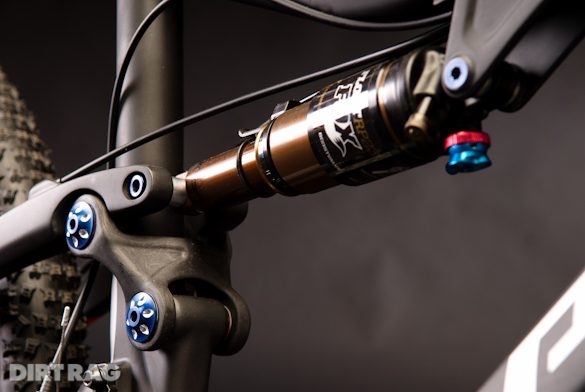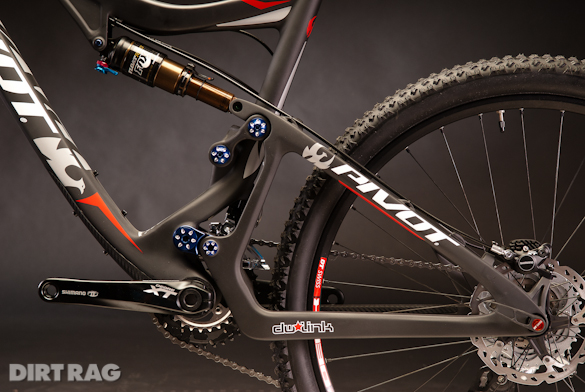Review: Pivot Mach 5.7 carbon
Originally posted on February 14, 2014 at 9:59 am
One bike to do it all—that’s the idea behind Pivot’s Mach 5.7. While the definition of “all” depends to a large extent on the rider, with its 145mm of rear travel and 26-inch wheels, the versatile Mach 5.7 is exactly the style of bike that would top my shopping list.
Chris Cocalis of Pivot Cycles gave me his take on the intended applications for this steed: “The Mach 5.7 is not an XC race bike, and it’s not a freeride bike; it’s really designed for everything in between. We consider it a do-all mountain bike, and that is the reason it is our best seller.”

The Mach 5.7 Carbon has the same 67 degree head angle (with stock 150mm-travel fork) and 13.7-inch bottom bracket height as the aluminum Mach 5.7. I feel that those numbers suit the all-arounder intent of the Mach 5.7.
In the past, Dirt Rag has covered the anti-squat characteristic of the dw-link suspension—utilized on all of Pivot’s full suspension bikes (for the gory details, check out dw-link.com). In a nutshell, a dw-link combats suspension bob (compression of the suspension due to pedaling) via careful placement of the pivots, rather than by relying on platform damping via the rear shock.
Pivot chose the Mach 5.7 as its first carbon fiber frame for a couple of reasons. When the company introduced the 5.7 in aluminum, it quickly became its best-selling bike. It also happens to be the bike that Cocalis rides the most; that sealed the deal.

I really took a shine to the rugged yet sexy look of the carbon frame. I like the way the oversized main tubes meld seamlessly into the tapered head tube and 92mm-wide BB shell. Routing the cables (and guides for a dropper-post cable) neatly under the top tube keeps the total package looking uncluttered. The matte black finish appeals to my conservative tastes, but I find the large number of Pivot decals too loud for my liking.
The frame lacks ISCG tabs. Pivot told me that chainguides that attach to the frame’s direct-mount front derailleur tabs have proven quite effective, especially with the new generation of clutch-style rear derailleurs. Alternatively, one could run a Bionicon C-Guide.
Our medium Mach 5.7 Carbon with the 2012 XT build kit (2×10) and Fox Float 150 FIT RLC fork (32mm stanchions with a 15mm thru-axle) tipped our scale at a respectable 26lbs. (sans pedals), and sported a price tag of $4,999 (the equivalent aluminum version goes for $4,599). Pivot offers seven build kit options, so there’s no lack of price/parts options from which to choose.

Using the supplied clip-on visual gauge, I set up the rear suspension to the recommended 30 percent sag. Easy peasy. The rear suspension barely bobbed at all while I was pedaling. Except for extended road climbs, I left the rear shock platform switched off. There are some efficient-pedaling bikes out there, and the Mach 5.7 is among the best.
The dw-link suspension is one of my favorite designs. I like the way it balances pedaling efficiency with very little sacrifice in terms of plushness. When the suspension was operating in its mid-range, the Mach 5.7 felt very plush and made square-edged bumps disappear, and it never felt wallowy.
When pushed to its limit on big hits, there was no harsh ramp-up at the end of stroke. In fact, the rear-end plushness made me wish that we’d ordered our test bike with the next level of kit, which included the plusher-feeling Kashima-coated Fox Float fork.
One minor complaint is that the Mach 5.7’s rear suspension did not feel as plush over small bumps as suspension designs employ less anti-squat. The problem I have with those more-active designs is that they tend to wallow under pedaling. When riding such bikes, I tend to dial up the platform to combat pedal bob, which ends up negating any small-bump plushness, except when I bother to reach down and switch the platform off. I’m the kind of guy that prefers a bike that strikes a pedalable/plushness balance all the time, without having to flip switches, so the Mach 5.7 suited my style.

My initial rides on the Mach 5.7 had me scratching my head over the fact that the handling felt quicker than the geometry numbers would suggest. Pedaling along rolling singletrack, the bike felt surprisingly neutral, neither particularly quick nor super slack. I’d slot the handling on the long-legged-trail-bike end of the 150mm-bike spectrum, as opposed to the gravity playbike end.
I discussed the handling with Cocalis, and he told me that under pedaling power the anti-squat feature of the rear suspension keeps the rear suspension from compressing and the geometry from slackening. This design feature is intended to help avoid issues with the front end wandering on climbs or the cranks smacking roots and rocks.
Downhill, the bike rode more like the geometry numbers would suggest. This change in character can be explained by the fact that when coasting downhill there is zero anti-squat, which allows the bike to sag and adopt a slacker head tube angle and lower bottom bracket. Even when pedaling on a downslope, the anti-squat is greatly reduced (compared to flat ground) because the rider’s center of mass is in a different location relative to the suspension. While the Mach 5.7 felt reassuringly stable at speed, it did not feel as carvy and slack as some 150mm bikes I’ve ridden. I keep coming back to the thought that the Mach 5.7 feels like a long-legged trail bike designed with the cross-country rider in mind, rather than a gravity-fueled fiend.

I was impressed by the ability of the Mach 5.7 to plow through rock gardens strewn with potential wheel-stoppers. If I couldn’t clean a section on the Mach 5.7, then I probably couldn’t clean it on any bike. In rocky terrain, I experienced the occasional pedal strike, about on par with similar bikes. (I noted more frequent pedal strike when pedaling down hills, likely a result of the increased sag.)
The carbon frame felt solid and free from unwanted flex. I didn’t feel any lateral flex in the main frame or the rear triangle. When I steered the bike into the gnar, I could count on the front wheel to always end up where I expected it to be.
Final Thoughts
The Mach 5.7 offers outstanding pedaling efficiency for a bike with nearly six inches of rear travel. Combine that efficiency with all-arounder handling, and the Mach 5.7 Carbon adds up to a great bike for cranking out all-day trail rides. The 32mm fork and lack of ISCG tabs make it clear that those looking for a burly, all-mountain rig should look elsewhere. On the other hand, the light carbon frame has endurance rides written all over it. The Mach 5.7 Carbon is a sweet XC bike with long legs. Hubba, hubba.

Vital stats
- Wheelbase: 44 inches / 1,117mm
- Head Angle: 67 degrees
- Seat Tube Angle: 71 degrees
- Bottom Bracket: 13.7 inches / 348mm
- Chainstay Length: 16.9 inches / 429mm
- Weight: 5.4lbs. (frame and shock), 26lbs. (as tested) / 2.5kg (frame and shock), 11.8kg (as tested)
- Sizes: XS, S, M (tested), L, XL
- Price: $4,999